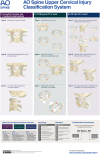Validating the Hierarchical Nature of the AO Spine Upper Cervical Spine Injury Classification System
- PMID: 39960095
- PMCID: PMC12180700
- DOI: 10.1097/BRS.0000000000005297
Validating the Hierarchical Nature of the AO Spine Upper Cervical Spine Injury Classification System
Abstract
Study design: Global cross-sectional survey.
Objective: To validate the hierarchical nature of the AO Spine Upper Cervical Spine Injury Classification (UCIC) across AO geographical regions/practice experience.
Summary of background data: To create a universally validated scheme with prognostic value, AO Spine established an upper cervical spine injury classification involving three elements: injury morphology (region: I-occipital condyle and craniocervical junction; II-C1 ring and C1-2 joint; III-C2 and C2-3 joint), and (subtype: A-isolated bony injury; B-bony/ligamentous injury; C-displaced/translational injury), neurological status [N0-intact; N1-transient deficit; N2-radiculopathy; N3-incomplete spinal cord injury (SCI); N4-complete SCI, and NX-unable to examine], and case-specific modifiers (M1-injuries at risk of nonunion; M2-injuries at risk of instability; M3-patient specific factors; M4-vascular injury).
Materials and methods: Totally, 151 AO Spine members (orthopaedic and neurosurgery) were surveyed globally regarding the severity (zero-low severity to 100-high severity) of each UCIC variable. Primary outcomes were differences in perceived injury severity score (ISS) over various geographic/practice settings, level of experience, and subspecialty.
Results: One hundred forty-eight responses were received. There was an increase in median perceived severity as each anatomic region (I-III) progressed from types A to B to C. Neurological status progressed similarly, except N1 and N2 were perceived similarly. Modifier M2 was perceived more severely than M3. There were no differences in ISS among levels of surgeon experience. There were small geographic differences with respondents from North and Central and South America perceiving types IC ( P =0.003), IIB ( P =0.003), and IIIB ( P =0.003) somewhat more severely than other regions. Neurosurgeons perceived types IB ( P =0.002) and IIIB ( P =0.026) as more severe than orthopaedic spine surgeons.
Conclusions: The AO Spine UCIC has overall excellent hierarchical progression in subtype ISS. These findings are consistent across geographic regions, spine subspecialty training and experience levels.
Keywords: AO Spine; global; hierarchical; injury severity score; upper cervical spine injury classification; validation.
Copyright © 2025 The Author(s). Published by Wolters Kluwer Health, Inc.
Conflict of interest statement
The authors report no conflicts of interest.
Figures
References
-
- Anderson PA, Montesano PX. Morphology and treatment of occipital condyle fractures. Spine. 1988;13:731–736. - PubMed
-
- Tuli S, Tator CH, Fehlings MG, et al. Occipital condyle fractures. Neurosurgery. 1997;41:368–376; discussion 376–377. - PubMed
-
- Traynelis VC, Marano GD, Dunker RO, Kaufman HH. Traumatic atlanto-occipital dislocation. Case report. J Neurosurg. 1986;65:863–870. - PubMed
-
- Bellabarba C, Mirza SK, West GA, et al. Diagnosis and treatment of craniocervical dislocation in a series of 17 consecutive survivors during an 8-year period. J Neurosurg Spine. 2006;4:429–440. - PubMed
-
- Dickman CA, Greene KA, Sonntag VKH. Injuries involving the transverse atlantal ligament: classification and treatment guidelines based upon experience with 39 injuries. Neurosurgery. 1996;38:44–50. - PubMed
Publication types
MeSH terms
LinkOut - more resources
Full Text Sources
Medical
Research Materials
Miscellaneous


